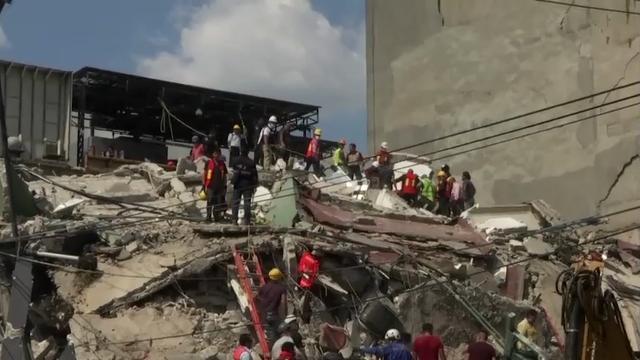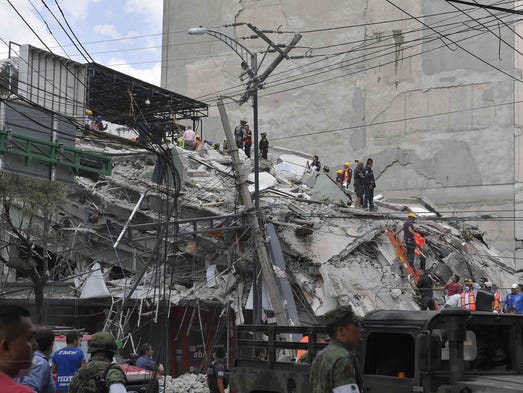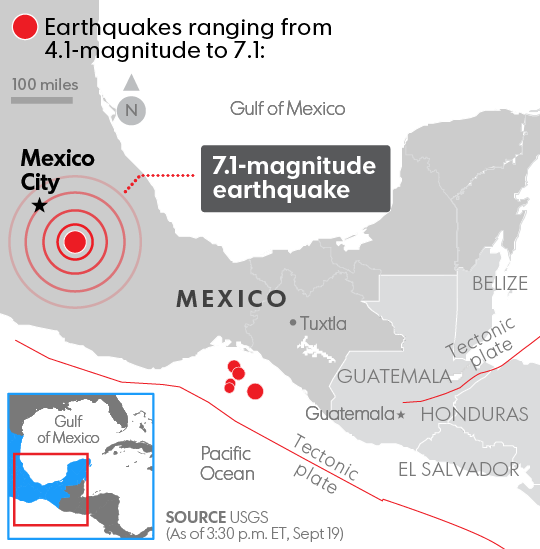
The death toll in Mexico's magnitude 7.1 quake continues to rise. At 6pm Eastern, it rose to 119, that's the largest number of fatalities in a Mexican earthquake since the 1985 quake that killed thousands. (Sept. 19) AP
MEXICO CITY — At least 149 people were dead after a magnitude-7.1 earthquake struck on Tuesday, crumbling dozens of buildings across a wide area 32 years to the day after a major quake devastated the capital city in 1985.
The earthquake was the second to strike in 12 days. An earlier temblor rocked southern Mexico and shook the capital.
On Tuesday, residents spilled out of buildings — many stayed in the streets until authorities inspected their buildings. Sirens blared throughout the afternoon. Federal Police were spotted bringing in sniffer dogs to find victims.
Many of those in the streets said the force of the quake was as strong as the 1985 earthquake, which claimed thousands of lives, left many more homeless and reduced parts of the city to rubble.
“This was the same as 1985. It shook bad,” said Gustavo de la Cruz, a parking lot attendant. He spotted a light fixture falling from a pole, but said the damage appeared a less severe as the last time. “That 1985 earthquake wrecked Mexico City,” he said.Others saw the damage first-hand. “There was this explosion,” said Ubaldo Juárez, a barber, who was riding his bike through the trendy, but hard-hit Condesa neighborhood. “I saw this cloud of dust, like something out of a movie.”
The Sept. 7 earthquake triggered an alarm system in Mexico City — quakes often occur far from the capital, which offers a window of 45 seconds to one minute to evacuate buildings. That didn’t occur this this time.
“Normally you have a warning. But this just struck,” said Juárez, who got down on his hands and knees to brace himself.
The earthquake came ironically on the same day as the 1985 earthquake. It’s a day when Mexican civil protection officials conduct earthquake drills — and office workers, students and apartment dwellers practice abandoning their buildings.
An earthquake drill occurred barely two hours before the Tuesday earthquake hit.
The 1985 quake killed an estimated 9,500 people and destroyed about 100,000 homes. That quake, a stronger magnitude-8.1, was only one of several over the past few decades to hit Mexico, one of the most seismically active regions in the world.
Mayor Miguel Angel Mancera on Tuesday said buildings fell at 44 places in the capital alone.
President Enrique Peña Nieto tweeted that he was on a flight to Oaxaca when the quake struck, but he returned immediately to Mexico City, where the international airport suspended operations as personnel checked structures for damage.
Throughout the city, rescue workers and residents dug through the rubble of collapsed buildings seeking survivors, AP reported. At one site in the city's Roma neighborhood, rescue workers cheered as they brought a woman alive from what remained of a toppled building. After cheering, the workers immediately called for quiet again so they could listen for the sound of survivors under the rubble.
President Trump, whose promise to build a border wall separating the USA and Mexico has antagonized Mexicans, on Tuesday tweeted: "God bless the people of Mexico City. We are with you and will be there for you."
In a statement, State Department spokesperson Heather Nauert offered condolences "to any who were injured or lost loved ones" on Tuesday. "Our thoughts and prayers are with the people of Mexico affected by today’s 7.1-magnitude earthquake and other recent natural disasters. We stand ready to provide assistance should our neighbors request our help."
Nauert said the U.S. Embassy in Mexico City stands ready to provide consular assistance to any U.S. citizens affected by the earthquake.
Luis Felipe Puente, head of the national Civil Defense agency in Mexico, said on Twitter late Tuesday night that the confirmed death toll had been raised to 149.
Parents and bystanders desperately tried to rescue students trapped in a collapsed school in southern Mexico City. Peña Nieto, who visited the Enrique Rebsamen school, said that 22 people died from the collapse. It’s not clear whether the deaths are already included in the overall toll of at least 149 across the country, The Associated Press reported.
According to Animal Politico, at least 30 children, including eight adults, are still missing.
In Cuernavaca, just south of Mexico City, Reuters reported that residents were pinned beneath collapsed buildings.
In Puebla, southeast of the capital, Gov. Tony Gali tweeted that an unspecified number of buildings were damaged, saying, "We deeply regret the loss of life following the #earthquake. My government is acting and providing all the necessary support."
The quake's epicenter was near the town of Raboso, about 76 miles southeast of Mexico City, the U.S. Geological Survey said.
The quake came just 12 days after a magnitude-8.2 quake struck several states along Mexico's Pacific Coast, leaving at least 90 dead.
On Mexico City’s main boulevard, thousands of people streamed out of buildings into the streets in a panic, filling the plaza around the Independence Monument with a mass of people.
Traffic came to a standstill, as masses of workers blocked streets. Clouds of dust rose from fallen pieces of facades.
In one short video posted to Twitter, bystanders watched as a five-story apartment building buckled and crumbled to the street in a shower of dust and debris.
In the city’s Roma neighborhood, which was struck hard by the 1985 quake, small piles of stucco and brick fallen from building facades littered the streets.
Two men calmed a woman, blood trickling from a small wound on her knee, seated on a stool in the street, telling her to breathe deeply.
Araceli Torres, a skin care product distributor, was at Mexico City's Centro Santa Fe shopping center when the earthquake struck. Having lived through the 1985 earthquake, Torres instantly recalled the terrifying feeling she experienced 32 years ago.
"Suddenly everything started shaking," Torres, 54, said. "I think that those who lived through the earthquake back in '85 experienced a psychosis because it started out really hard. ... I felt as if my heart was going to jump out of my chest."
Torres walked toward a roofless parking lot near the mall and said she had never seen so many people there before. People looked nervous — some were crying and some even asked for her phone because no one else had signal.
"This is very painful because it reminds you of what the experience was like back in '85," she said. "Back then it looked as if we had been in a city that had just been bombarded. You could breath a lot of sadness today."
Though the earthquake of '85 was substantially more destructive and damaging, Torres said she can still see the same kind of solidarity among people: Neighbors or simply people on the street helping others stay calm.
Residents in the Col. Condesa neighborhood and across the city came armed with buckets to help with rescue efforts — many were still wearing their work clothes and arrived straight from the office.
"The boss sent everyone home. I came to help," said Gonzalo Hernandez, a lawyer still wearing a white dress shirt. "Everyone is asking, 'How can I help out?'"
Volunteers formed long rows to pass buckets full of rubble from a collapsed building. Others brought sandwiches and oranges to feed the volunteers. Urgent calls went out for portable lights to allow rescuers to work and doctors to attend to the injured. Power had been restored in some parts of the city, but the most impacted areas were still in the dark.
The scene was a reminder of the rescue efforts after the 1985 earthquake, when the government response was slow and residents were forced to fend for themselves. Teams formed to dig through rubble — which at the time included hospitals, apartments and hotels. The then president Miguel de la Madrid dithered and even rejected foreign assistance when first offered.
Gala Dluzhynska was taking a class with 11 other women on the second floor of a building in the Roma neighborhood when the structure collapsed. Dluzhynska said the building’s stairway was very tight and surrounded with glass. As they ran out of the building, everything started falling around them. Some people panicked, she said. Dluzhynska said she fell in the stairway and others began to walk over her.
She shouted for help and someone pulled her to her feet. She said the dust was so thick you couldn’t see anything.
“There weren’t any stairs anymore only rocks,” she said.
She said they were still looking for one classmate who was missing.
Contributing: Amanda Trejos, AP. Follow David Agren on Twitter: @el_reportero. Follow Greg Toppo on Twitter: @gtoppo.
Marvin X travels in Mexico City, the Caribbean, Central and South America
In a career spanning more than 70 years, Elizabeth Catlett has created sculptures that celebrate the heroic strength and endurance of African-American and Mexican working-class women. With simple, clear shapes she evokes both the physical and spiritual essence of her subjects. Her hardy laborers and nurturing mothers radiate both power and a timeless dignity and calm. Whether working in wood, stone, bronze, or clay, Catlett reveals an extraordinary technical virtuosity, a natural ability to meld her curving female forms with the grain, whorls, color, or luster of her chosen medium. The beauty of her subjects is matched by the beauty she reveals in her sculptural materials.
Throughout her career, Catlett has been a political progressive committed to improving the lives of African-American and Mexican women, and she has often used her art explicitly to advance their cause. She has also protested, picketed, and even been arrested in her quest to win justice for those she describes as "my people." Moving from the United States to Mexico in 1946, she was eventually identified as an "undesirable alien" by the U.S. State Department. For nearly a decade she was barred from visiting the United States.
Despite these struggles, Catlett's art reveals no trace of bitterness or despair. Indeed, she has remained true to the universal, life-affirming themes that first animated her sculpture in the 1940s'the beauty of the human form and the nobility of the human condition. At age 95, she continues to create, guided by those unshakeable ideals.
| Jeff Harrison Chief Curator, Chrysler Museum of Art |
Marvin X in Harlem, New York, 1968, working underground in the Black Arts Movement while the FBI was seeking his arrest for refusing to fight in Vietnam. In Harlem he was part of the Black Arts Movement. His associates were Askia Toure, Amiri Baraka, Sonia Sanchez, Nikki Giovanni, Last Poets, Haki Madhubuti, Mae Jackson, Ed Bullins and the New Lafayette Theatre family where he worked as associate editor of Black Theatre Mgazine; Sun Ra, Milford Graves, Barbara Ann Teer,
et al. He also was in contact with Minister Louis Farakhan and Larry X (Akhbar Muhammad) at Mosque #7 in Harlem.
He eventually served five months in Terminal Island Federal Prison for refusing to be a lackey for American imperialism. While in prison, he studied, wrote and served as Nation of Islam minister. The brothers held an "election" in the big yard, they said, "Marvin X, you the smartest, you the minister." Another brother was appointed secretary and the speak appointed himself captain. :"We did not dispute the "election" in the big yard.
In his autobiography Somethin' Proper, Marvin X covers his exile in Toronto, Mexico City and Belize, Central America. His bio is a critical narrative of the Black Arts Movement, along with Amiri Baraka's and Haki Madhubuti's. We await the Sonia Sanchez autobiography. See the BAM classic Black Fire and the BAM reader SOS, edited by Sonia Sanchez, John Bracey and James Smethurst.
We send our prayers to all the people in Mexico City and the Caribbean. We have a special relationship with Mexico and the Caribbean as well. Mexico gave us refuge as a draft resister during the Vietnam War, as did Belize, although Belize did deport me back to the USA and I served five months in Federal Prison, San Pedro, CA. And ironically, after serving time and not long after my release from Terminal Island Federal Prison, I was awarded a National Endowment for the Arts writing fellowship that enabled me to travel back to the Caribbean and South America. See my court speech published in Black Scholar Magazine, along with my interview with Prime Minister Forbes Burnham of Guyana, South America, who turned out to work for the CIA and sadly, not only was Pan African master scholar Dr. Walter Rodney killed on his watch but the Jim Jones massacre occurred as well.
During our exile in Mexico City (along with other young brothers from throughout Latin America), I was educated on the Mexican revolution the first night I arrived at my contact's house, the great North American African revolutionary artist, Elizabeth Catlett Mora.
She and her artist husband Poncho Mora were witnesses at my civil wedding to Hasani, aka Barbara Hall, mother of my daughters Nefertiti and Amira. Hasani and I lived near the earthquake area, cerca de metro, cerca Pasao de la Reforma, cerca Chapultepec Park, not far from the Zona Rosa or the Gringo section of town.
For giving me refuge from American imperialism, I have nothing but love for Mexico, although the country is a contradiction. Alas, a few months before I arrived students were massacred at the National University and when parents arrived to check on their children, the parents disappeared!
'Again, let us pray for the dead and injured in the earthquake and pray for all those suffering in this country that has given refuge to so many forced into exile from throughout the Americas. I met many brothers and sisters exiled in Mexico City from Columbia, Dominican Republic, Venezuela, Cuba, Belize and elsewhere. Alas, I met diplomats from the Caribbean who could not buy black books from me because they could not return home to Jamaica, Trinidad and other islands even though they were diplomats because black literature was banned.






































No comments:
Post a Comment